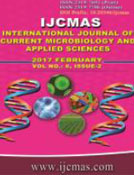


 National Academy of Agricultural Sciences (NAAS)
National Academy of Agricultural Sciences (NAAS)

|
PRINT ISSN : 2319-7692
Online ISSN : 2319-7706 Issues : 12 per year Publisher : Excellent Publishers Email : editorijcmas@gmail.com / submit@ijcmas.com Editor-in-chief: Dr.M.Prakash Index Copernicus ICV 2018: 95.39 NAAS RATING 2020: 5.38 |
The potential contribution of trees to soil improvement is one of the major assets of agroforestry in general and more specifically agroforestry lands. Agroforestry systems are often mentioned as type of sustainable agriculture. However, long term studies on the sustainability of this land use do not exist. The study was conducted at Agroforestry Research Farm, Nagpur to know the soil nutrient status of teak and bamboo plantations and to evaluate the soil nutrient status in agroforestry research farm which was compared with cultivable land. Soil samples were taken from different depths 0-15 cm and 15-30 cm of 8-19 year old teak, 14-19 year old bamboo plantations and farm land, respectively. Samples were analyzed for pH, organic carbon, inorganic carbon, available N, P, K, S and Exchangeable Ca and Mg. Soil pH was significantly lower in the teak (1994, 3X3m) followed by other plantations and higher pH was observed in cultivable land. Bamboo plantations had significant higher organic carbon, inorganic carbon, available potassium, sulphur and exchangeable calcium and magnesium concentrations than teak plantations and farm land. Available nitrogen was significantly higher in teak plantations than bamboo and farm land, available phosphorus was significantly higher in Teak (1994 3X3m) followed by bamboo plantations and cultivable land. Teak and Bamboo plantations with carefully evaluated agroforestry species could be employed as productive soil ameliorations in arid and semiarid soil of India.
 |
 |
 |
 |
 |